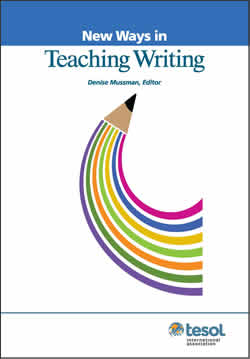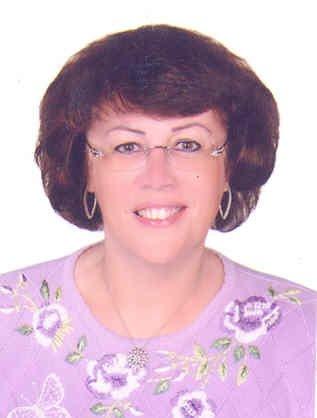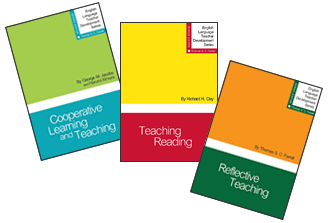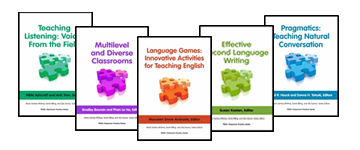New Year's Resolutions for English Language Teachers
Compiled by Tomiko Breland
It is believed that the practice of setting New Year’s resolutions began some 4,000 years ago, with the ancient Babylonians. At the beginning of the year, they would make promises to their gods in order to have good favor bestowed on them for the rest of the year. Today, people the world over make New Year’s resolutions to better themselves in some way, personally or professionally; English language educators are no exception.
Here are just a few of the 2014 New Year’s resolutions set by English language teachers from around the world with the hopes of pursuing excellence in English language education. What will your New Year’s resolution be this year?
I resolve…
“…to spend more time with students to get to know them as people rather than as numbers.”
Sarah McGregor, San Jose State University, California USA
“…to commit myself to creating a learning environment that favors reflective practices and teacher autonomy. In 2014, I would like to support professional development through the creation of a teachers’ association to promote teacher autonomy and to encourage research-based activities within the teaching community.”
Vino Sarah Reardon, CFS, University of Buraimi, Oman
“…to focus more on the students instead of the final outcome. As a teacher, I want to push my students to a higher proficiency level, but oftentimes I forget that I am teaching students who have emotions and needs. I will be patient, and I will let them know that I am there to help them.”
Judy Ma, Brigham Young University, Utah USA
“…to sing more with my students. Music can give us courage to stand up to injustice. It can help us as TESOL educators to link teaching English with social responsibility. As we witnessed in the tributes to Nelson Mandela, the South African freedom songs inspired people around the world to get involved in the movement against apartheid. A song can lift our spirits. In the language classroom, singing can help students who are tongue-tied and self-conscious. Music can energize students and teachers alike—especially those who have all worked long hours before coming to class! Music is a great motivator.”
Shelley Wong, George Mason University, Virginia USA
“…to cull through 20 years of resources and handouts. Then, define and use a more efficient and organized method to store teaching resources.”
Cristin Boyd, San Jose State University, California USA
“…to continue to help all teachers understand that English learners can respond to higher-order thinking questions no matter what English language development (ELD) level. We, as teachers, can be more creative in our approach to facilitating learning for all learners.”
Judith B. O'Loughlin, CATESOL Education Foundation, USA
“…to flip my class in the new year, making use of my university Moodle in addition to teachem and showme. This idea will help my students regulate their learning.”
Mohamed EL Zamil, Ajman University of Science & Technology, UAE
“…to use more student-centered teaching methods in the New Year. I am already to increase student involvement by requiring several projects throughout the semester and as a final exam in my oral English classes. With classes averaging about 50 students, team work will be needed."
Gayla Baker, Hangzhou Polytechnic College, Zhejiang Province, PRC
“…to enjoy teaching more by stressing about it less.”
Sarah Jackson, San Jose State University, California USA
TC Monthly Giveaway Congratulations to Maureen Sargent, of Nova Scotia, Canada, for being the winner of the December 2013 TESOL Connections Monthly Giveaway. Maureen won a free TESOL membership renewal.
This month, TESOL is giving away
two free copies of our latest book:
New Ways in Teaching Writing, Revised

2 copies: One for you, and one for a colleague!
This book is packed with more than 100 updated activities adapted for technology, low-resource classrooms, higher education, EFL, workplace literacy, adult immigrant education, K-12, or corporate training.
Click here to enter
Drawing closes 29 January 2014, 11:59 pm EST
TESOL Blogs Interested in writing a blog for TESOL?
Contact Tomiko Breland with your idea or for submission details.
Check out the latest TESOL Blogs:
|
8 Current Trends in Teaching and Learning EFL/ES, by Deena Boraie
 The TESOL President’s Blog The TESOL President’s Blog
Last month, I had the good fortune of having been invited as a plenary speaker in MexTESOL’s 40th anniversary convention, held in lovely Querétaro. I had a wonderful time, and I really felt at home—I discovered that Mexicans have a lot in common with my people (Egyptians). During the convention, I was also asked to give a talk about the current trends in English language teaching and learning in an EFL or ESL context. I was very pleased to do so, and here are the key eight trends that I talked about. These are not necessarily an exhaustive list and most likely there are other trends that I have not mentioned. Read More. |
|
Writing-to-Learn Activities, by Elena Shvidko
 Many of you are probably familiar with writing-to-learn (WTL) activities—“Short, impromptu or otherwise informal writing tasks that help students think through key concepts or ideas presented in a course. Often, these writing tasks are limited to less than five minutes of class…” (Definition from the WAC Clearinghouse). Writing-to-Learn activities can be used in any situations where students could benefit from thinking deeply about what they are doing in class, or why they’re doing it. In today’s blog entry, I synthesize the information that I found about writing-to-learn activities and share the activities’ purposes, how to implement them at different times during class periods, and how they can be used across the skills. Read More. Many of you are probably familiar with writing-to-learn (WTL) activities—“Short, impromptu or otherwise informal writing tasks that help students think through key concepts or ideas presented in a course. Often, these writing tasks are limited to less than five minutes of class…” (Definition from the WAC Clearinghouse). Writing-to-Learn activities can be used in any situations where students could benefit from thinking deeply about what they are doing in class, or why they’re doing it. In today’s blog entry, I synthesize the information that I found about writing-to-learn activities and share the activities’ purposes, how to implement them at different times during class periods, and how they can be used across the skills. Read More.
|
|
Eavesdropping on the Present Perfect, by Alexandra Lowe
 Perhaps no frequently used tense in the English language is as bedeviling as the present perfect tense. Many advanced ESL students still struggle to use it correctly. And plenty of instructors—myself included—have struggled to teach it well. Perhaps no frequently used tense in the English language is as bedeviling as the present perfect tense. Many advanced ESL students still struggle to use it correctly. And plenty of instructors—myself included—have struggled to teach it well.
This fall, after several semesters of doing valiant battle with this tense, I decided to adopt a new approach. Instead of dutifully marching my students through our textbook’s chapters on using the present perfect with “since” or “for” or “already, yet, and still,” I decided to lay the groundwork for our work on the present perfect by asking them to listen to how people at work, on the street, in the movies, and on the Internet actually used this tense. Their assignment was to “eavesdrop” on the English language as it was being spoken around them outside of class, to listen for the use of the present perfect, to write down what they heard, and to bring the sentences they overhead to class. Read More. |
|
Best Language Learning Games: Part 3 of 5, by Marc Anderson
 This is the last article in a series of recommended language games for ELLs. As I mentioned in the first article, I was cleaning out my files and moving classrooms for the beginning of a new school year recently, when I stumbled upon this box of homemade language games. I was reminded of how much language progress the students made with these games and how much fun they had, too. I thought you might like to hear my choices of the Best Learning Games. This week’s game is I Have, You Have (Learning English) which is based on a popular game that provides reinforcement with various academic skills through an interactive group activity. Read More. This is the last article in a series of recommended language games for ELLs. As I mentioned in the first article, I was cleaning out my files and moving classrooms for the beginning of a new school year recently, when I stumbled upon this box of homemade language games. I was reminded of how much language progress the students made with these games and how much fun they had, too. I thought you might like to hear my choices of the Best Learning Games. This week’s game is I Have, You Have (Learning English) which is based on a popular game that provides reinforcement with various academic skills through an interactive group activity. Read More.
|
TESOL Bookstore

It’s a new year, and teachers are looking for fresh ideas in professional development. These books from TESOL Publications are written by TESOL professionals who share their insights and perspectives with the field.
Now available for FREE SHIPPING*

English Language Teacher Development Series
Thomas S. C. Farrell, series editor
Affordable Professional Development in a Booklet!
What’s the latest research, and how do I use it in my classroom? Keeping updated is an ongoing task for a profession that continuously reinvents itself. This series covers 15 topics of immediate relevance to practicing teachers in ESL, EFL, EIL, and ESOL classrooms. Ideal for ESOL master’s programs and skills courses.

TESOL Classroom Practice Series
The TESOL Classroom Practice Series presents more than150 best practices and activities covering 15 topics contributed by teachers around the world for teachers around the world.
*Free shipping for up to 5 books to USA and Canada!
To Order:
Online: www.tesol.org/bookstore
|
 |
|
|
 |
| IEP Faculty (Full time), Spring Int'l Language Center, University of Arkansas, Fayetteville, Arkansas USA
Lecturer, English Language Improvement Program, Ohio University, Athens, Ohio USA
Director, International Gateway Programs, California State University, Fullerton, California USA
Want to post your open positions to Job Link? Click here.
To browse all of TESOL's job postings, check out the TESOL Career Center. |
 |
|
 |
| ADVERTISEMENT |

|
 |
 |
|
|
 |
Submit to
TESOL Connections!
We're seeking new voices and innovative ideas for 2014:
Lesson Plans
Feature Articles
TC Quick Tips
Read our Submission Guidelines for full details. |
 |
|
 |
|